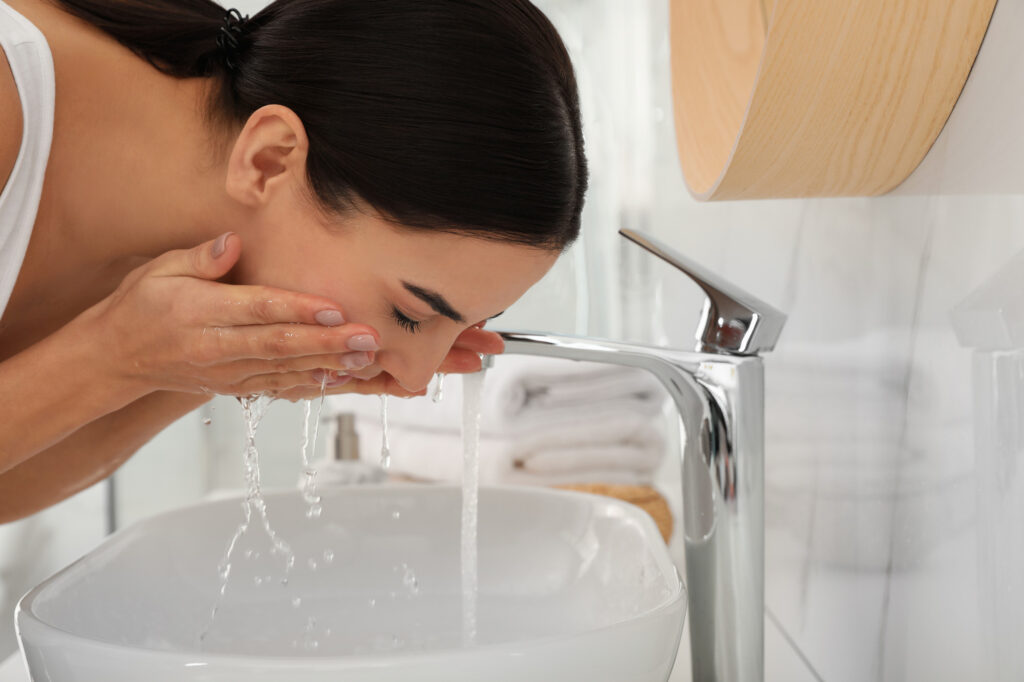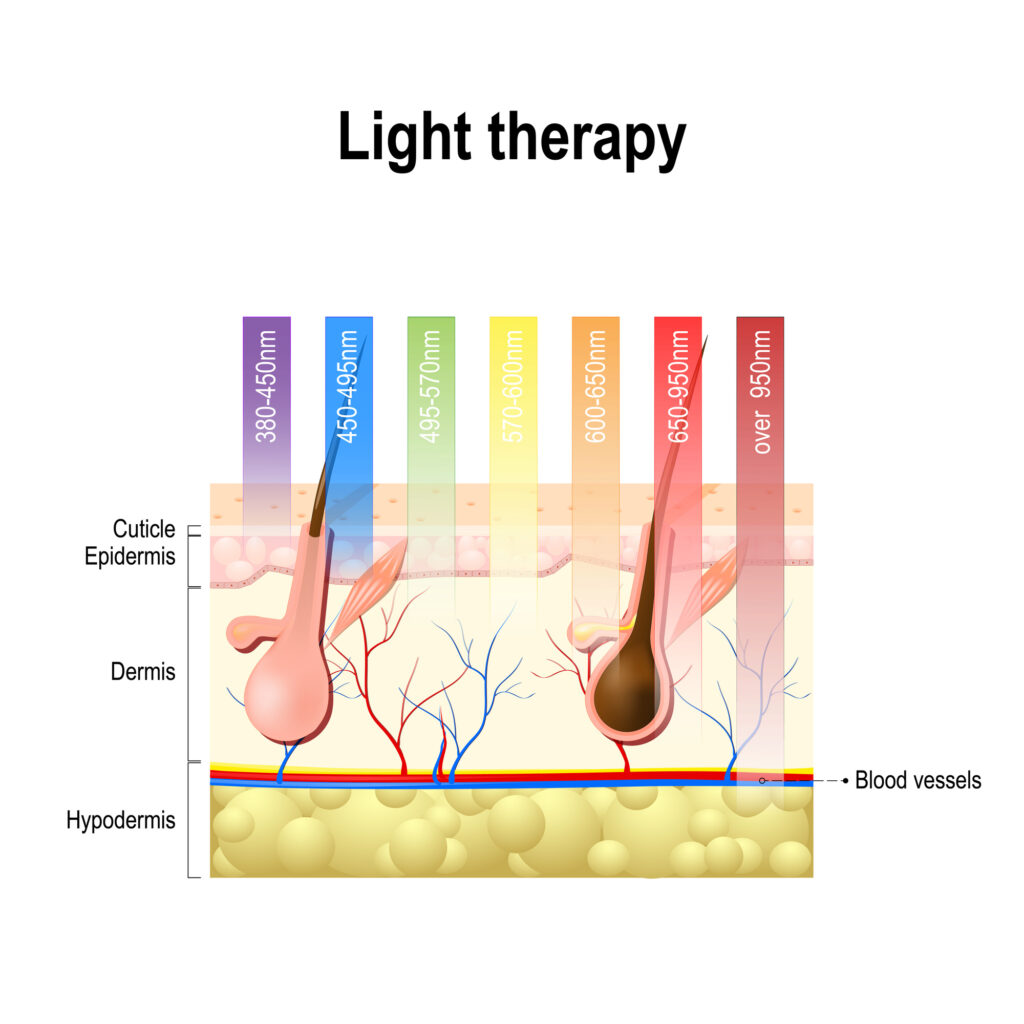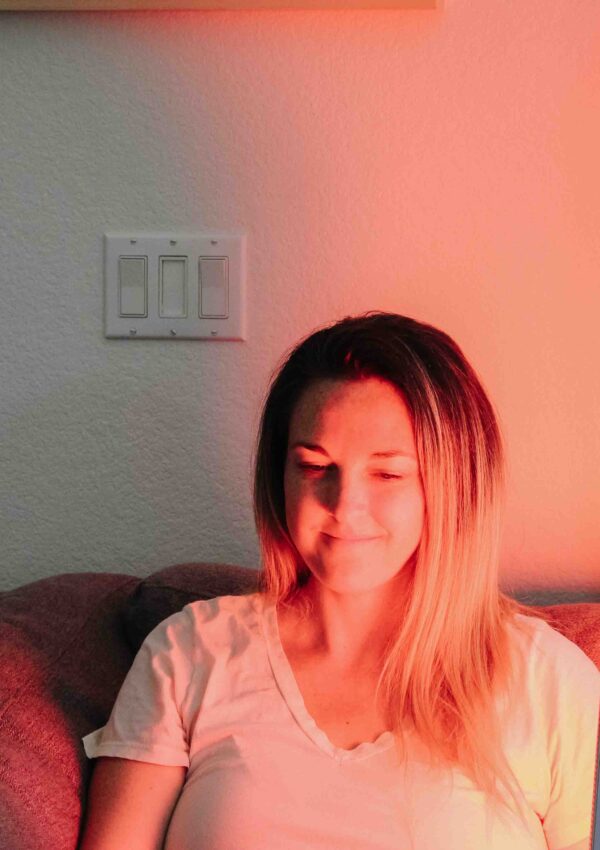Does using red light therapy for rosacea work? Learn what it does and different ways to do red light therapy at home and the doctor’s office.

Rosacea is a common skin condition affecting 14 million people worldwide, or about 5% of the world’s population. It is a chronic inflammatory condition of the face characterized by redness, broken blood vessels, and pimples.
While there is no cure for rosacea, there are effective treatments to keep it under control. We will discuss various treatments as well as using red light therapy for rosacea.
Companies like HigherDOSE are making red light therapies affordable and available for at home use. With products like the Red Light Face Mask, it’s easier than ever to target rosacea with red light therapy.
Disclaimer: This post includes affiliate links, and we will earn a commission if you purchase through these links. Please note that We’ve linked to these products purely because we recommend them, and they are from companies we trust. There is no additional cost to you.
What causes rosacea?
There is no known cause for rosacea, but there are known triggers and environmental factors that worsen rosacea. Recent research suggests there are genetic and immune-related components to rosacea.
In the past, most thought that bacterial infections primarily caused rosacea. Now we know there is a complex interplay of many factors which leads to rosacea. Many of which are still being discovered. Here are some of the potential causes of rosacea.
Genetics
Rosacea frequently runs in families. Patients with rosacea have a four times higher risk of having a family history. Women are more prone to getting rosacea. Also, fair-skinned people of Scandinavian or Celtic descent get rosacea more commonly. It affects about 20% of the population in those areas of the world.
Recently, rosacea has been linked to two types of genes: HLA and GST. The HLA genes are involved in the immune system. They help the body determine what is foreign. If that ability is damaged, the body will think everything is foreign and constantly produce excess inflammation.
The GST genes are responsible for destroying reactive oxygen species (ROS) that damage cells. Without the ability to destroy ROS, there will be excess cell death and inflammation.

Immune system
People with rosacea have an overactive immune system causing an exaggerated response to certain bacteria. It is believed that gut health plays a role in rosacea.
Infections
Patients with H. pylori infection in their stomach are more prone to getting rosacea.
Mites
Demodex mites live on everyone’s skin. Rosacea patients have a higher number of these mites and may also have an increased sensitivity to the mites.
Cathelicidins
These skin proteins that usually protect the skin from inflammation may be dysfunctional in patients with rosacea.
Impaired barrier function
The skin’s protective barrier may be dysfunctional in patients with rosacea. The skin’s protective barrier keeps water in and stops the penetration of bacteria, toxins, and other irritants. If the skin’s protective barrier is not functioning, the skin becomes inflamed, infected, and irritated. The skin also loses more water and becomes dry.
Rosacea patients should avoid these triggers
- Sun and tanning beds (ultraviolet radiation) – This is the number one trigger of rosacea and is easily preventable. Ultraviolet radiation (UV) stimulates excess VEGF production. VEGF is a growth factor responsible for blood vessel formation.
- Alcohol and red wine – Because these contain large amounts of histamine, they cause vasodilation and dehydration of the skin, which worsens rosacea.
- Chocolate – The theobromine in cocoa causes vasodilation.
- Tomatoes – Tomatoes also contain lots of histamine.
- Spicy foods – Spicy foods can cause flushing (we have recipes for a mild, nightshade free taco seasoning and a mild nightshade free salsa verde)
- Stress – Stress cause inflammation which worsens rosacea. It also releases cortisol which can trigger an outbreak of pimples.
- Hot drinks, like hot coffee – Hot drinks also cause flushing.
- Some blood pressure medications – Some are vasodilators, such as benazepril or hydralazine, which worsen rosacea.
- Extreme environmental temperatures – Extreme temperatures can irritate the skin and trigger a rosacea flare.
- Wind – Extreme wind can also irritate the skin and trigger a flare.
- Some skincare products – Products that contain retinoids (sometimes), acids, alcohol, fragrance, menthol, and camphor can worsen rosacea.
Rosacea and other autoimmune conditions
Rosacea is linked to other inflammatory and autoimmune conditions. If you have rosacea, you may be at risk of developing these other conditions, so talk to your doctor about your diagnosis.
These conditions include:
- Inflammatory bowel disease (Ulcerative colitis, Crohn’s disease)
- Multiple sclerosis
- Diabetes mellitus
- Heart disease (elevated blood pressure and high cholesterol)
- Celiac disease
- GERD (gastrointestinal reflux disease)
- Alzheimer’s disease
- Migraine headaches
- Rheumatoid arthritis
- Sarcoidosis
- Cancers – Thyroid, breast, basal cell carcinoma, brain, lung, gynecologic, and gastrointestinal cancers

What are the different types of rosacea?
Rosacea primarily affects adults with fair skin types. There are four different types of rosacea. They can present alone or in combination.
- Erythematotelangiectatic rosacea – This type of rosacea is the most common form. It consists of facial redness and broken visible blood vessels on the face. It is often mistaken for sunburn.
- Papulopustular rosacea (also known as acne rosacea) – This type mimics acne and leads to misdiagnosis. Rosacea sufferers can have pink bumps, pimples (whiteheads), and blackheads. Pimples form when dirt, oil, and bacteria get trapped inside the pores. Some even suffer from painful cystic lesions. Facial redness and broken blood vessels are also present.
- Phymatous rosacea (also known as rhinophyma) – This type of rosacea is rare and mostly affects men. It causes significant thickening, scarring, and disfigurement of the nose. The classic example of this type is seen in W C Fields.
- Ocular rosacea – This type only affects the eyes. It causes irritation, redness, and tearing of the eyes. It can be present with other types of rosacea or stand-alone.
What are the signs and symptoms of rosacea?
There are many signs and symptoms of rosacea. It usually presents on the cheeks, nose, chin, and forehead. Rosacea is more common in women. It usually appears in adults over 40 years of age.
- Flushing
- Persistent redness
- Broken visible blood vessels
- Pink-red bumps, pustules (whiteheads), and cysts
- Scars
- Red, watery eyes
- Itching
- Soreness or pain
What are the treatments for rosacea?
The most effective way to treat rosacea and get the best results is a combination of proper skin care with prescription medications and trigger avoidance.
In mild cases of rosacea, just avoiding triggers achieves significant improvement. If you suffer from rosacea, you should work with a board-certified dermatologist to create the right treatment plan for you. The sooner you begin a proper rosacea treatment plan, the quicker you will see results and the less chance of permanent scarring.
Proper skin care is necessary for everyone, especially for patients with skin issues or medical conditions like rosacea. The better you care for your skin, the better the treatments will work.
Proper Skincare

Cleansing
Wash your skin twice a day to get rid of dirt, oil, and bacteria that can damage your skin. Stick to a creamy face wash and not a bar soap. Because patients with rosacea have sensitive skin, proper product selection is critical.
Bar soap is very alkaline and can damage your skin’s protective barrier. If your barrier is damaged, you will experience more irritation, dehydration, and redness on your skin. Avoid dyes and fragrances because they can irritate your skin. Also, use an oil-free, non-comedogenic wash to prevent clogging your pores and getting more pimples.
Moisturizing
You also need to moisturize twice a day with an oil-free, non-comedogenic moisturizer. Many people falsely believe that oily skin does not need moisturizer. That is not true. All skin types benefit from moisturizer, but it has to be the right one for their skin type. If you do not moisturize, your skin will overproduce oil and cause more breakouts.
Sun protection
Since UV light from the sun and tanning beds triggers and worsens rosacea, you must protect your skin every day. Also, since rosacea targets fair-skinned people, protecting your skin will decrease your risk of premature skin aging and developing skin cancers.
Use a broad-spectrum sunscreen with UVA and UVB protection of at least SPF 30 daily. Reapply every 1-2 hours you are outside or driving in the car. Use a wide-brimmed hat, sunglasses with UV protection, and UPF clothing when outside. Limit your sun exposure, especially during peak hours of 10 am-4 pm. Avoid the use of tanning beds.
Topical Treatments
There are several over-the-counter topical treatments and topical prescription medications that help rosacea. It can take 6-8 weeks to see good results with topical treatments. The key is to be patient and consistent with your routine.
If you are pregnant, plan on becoming pregnant, or are breastfeeding, many treatments are not suitable and may cause harm to the baby. It is best to discuss your options with a dermatologist.
- Sulfur/ sodium sulfacetamide – These ingredients are present in many face washes and topical creams. They can dry up oil production, unclog pores, and reduce inflammation caused by rosacea.
- Metronidazole – It is a topical antibiotic that reduces the redness, swelling, and inflammation of rosacea.
- Clindamycin/erythromycin – These antibiotics can reduce the bacteria on the skin to prevent inflammatory pimples.
- Retinoids – Retinoids can exfoliate dead skin cells and unclog pores to treat and prevent pimples. As an added benefit, it also works at the cellular level to stimulate collagen production to remove fine lines, eliminate brown age spots, and help with skin rejuvenation. Some patients may experience worsening of rosacea with retinoids, so exercise care when using these. It is safer to try a test spot first.
- Azelaic acid – It can improve the redness and pimples of rosacea by decreasing inflammation. It also unclogs pores and kills bacteria to treat and prevent pimples.
- Brimonidine and Oxymetazoline – Both are topical liquids applied to the skin that temporarily constrict the blood vessels on the skin’s surface to improve facial redness.
- Ivermectin – Topical ivermectin kills the Demodex mites that live on the skin.
What is red light therapy?
There are many laser treatments and light therapy treatments that help rosacea. They are used alone or in conjunction with topical and oral treatments. To understand these treatments, you need to understand the light spectrum.
The light spectrum is a collection of many wavelengths (nm) of light, both visible and invisible. Visible light, which you can see with the naked eye, is 380-780nm. Invisible light, which consists of infrared, ultraviolet, and x-rays, as the name suggests, cannot be seen with the naked eye. Ultraviolet and x-rays fall below 380nm. Infrared light is above 780nm.

How does red light therapy work?
Red light and near infrared light is thought to be able to penetrate deepest into the skin. It is thought that red light therapy works by activating the mitochondria in our cells, which leads to cellular energy to heal and repair. As discussed above, rosacea is an inflammatory response. When cells can better function, they can repair and lower the inflammation.
This case study shows before and after photos and discusses benefits of light therapy for rosacea.
In addition to reducing rosacea symptoms, red light therapy has been shown to potentially benefit the following:
- Aid in muscle recovery
- Reduce inflammation
- Reducing scars/wrinkles
- Decreasing pain
- Increase scalp hair growth
- Reduction of fine lines and wrinkles and increase collagen
Red light therapy for rosacea
Red Light Lasers
Lasers emit only one particular wavelength of light to target and treat different aspects of rosacea, such as broken blood vessels/ redness, scarring, and pimples. Lasers can emit visible and invisible wavelengths of light. The different wavelengths correspond to whatever the target is. For example, blood responds best to light 585-595nm. Laser therapy is more invasive and must be performed in a doctor’s office.
- Nd: YAG 1,064nm laser and pulse dye laser 585 or 595nm lasers target broken blood vessels and redness.
- CO2 (10,600nm) and Erbium (2,940nm) lasers work on scars.
- Smoothbeam 1,450nm laser targets oil glands to stop the production of sebum/oil and subsequent inflammatory acne pimple formation.

Light therapy treatments are performed in a doctor’s office with professional devices or at home with devices made specifically for home use. Light therapy usually emits several wavelengths of light, not just one like lasers do. It is also less invasive and less painful. Because it is less invasive, it requires less downtime and is a more desirable treatment.
- IPL (Intense Pulsed Light) and BBL (Broad Band Light) treatments help with pimples and redness. It consists of several different wavelengths of light and color. The red light wavelength portion dries up sebum production. The yellow and green lights kill bacteria that cause pimples.
- PDT (Photo Dynamic Therapy) with blue light therapy helps with pimples. A liquid containing a photosensitizing ingredient is applied to your face and allowed to soak in. Then a blue light is aimed at your face to kill the bacteria causing pimples.
- LED light therapy (Light-Emitting Diode) emits blue or red light to help treat pimples. The blue light treatments kill bacteria that cause acne. The red light treatments dry up oil production to reduce breakouts. LED treatments can be performed in-office or at home. Red light may also improve wrinkles, scars, and wound healing by stimulating collagen production and increasing blood flow. It improves redness by decreasing inflammation. Also, red light treatments enhance skin healing in chemotherapy patients.

Red light therapy home devices
With red light therapy becoming more popular, there are a lot of red light therapy home devices available to purchase – often for the cost of just one laser treatment. Pricing will vary from a couple hundred dollars to thousands of dollars. It’s best to keep in mind what works for you and what you would like to get out of your red light therapy.
The HigherDOSE Red Light Face Mask is a great option that allows you to multi-task while wearing it. It stays on your face so you’re sure to be targeting the exact rosacea areas. It’s small, easy to travel with and comes with a rechargeable battery and carrying case.

The Truelight Light Therapy Energy Square 2.4 includes four different types of LED light therapy (red, yellow, deep red and near infrared). It’s a 12” x 12” square that makes the coverage area large enough to use for larger parts of the body and helps treat more than just rosacea. Extra bonus!
Use code WELLNESSTRICKLE for 10% off your TrueLight purchase!

The bottom line
Rosacea is a common but challenging medical condition to treat. It is multifactorial and often requires combination therapy to get superior results. Optimal treatment also requires good hygiene and avoidance of triggers. With consistency and patience, your skin will begin to look better, and you will feel better.
Without proper treatment for your rosacea, it will ultimately lead to permanent scarring of your skin and damage to your eyes that may result in vision loss.
Adding red light therapy into your rosacea treatment regime can help with symptoms and treating the rosacea at a cellular level.
Take action
If you suffer from rosacea, do not delay getting treatment. The sooner you get your rosacea under control, the less likely you will get permanent damage. Make an appointment and ask your dermatologist for treatment options.
If you do not have a dermatologist, check out www.aad.org to find a board-certified dermatologist near you. Also, discuss your diagnosis with your primary care doctor since rosacea is linked to other diseases. Talk to your doctor about how to mitigate risk factors for developing these other diseases.
If you are interested in home remedy treatments for rosacea, it’s important to take your gut health into consideration. Consider checking out our posts on gut health:
- Probiotics and Prebiotics: What’s the Difference and do I Need Both?
- 6 All Natural Home Remedies for Leaky Gut
- How Sugar Impacts Gut Health and What to do About it
If you would like to try an at home red light therapy device, the HigherDOSE Red Light Face Mask is a great option at an affordable price. It offers a hands free experience so you can multi-task while getting your red light in.
Truelight’s Light Therapy Energy Square 2.4 is a great, affordable product. Backed by science and Dave Asprey (a biohacking expert), it works well and is easy to use.
Use code WELLNESSTRICKLE for 10% off your TrueLight purchase!
It’s important to note that when using red light therapy for rosacea (and other ailments), it takes time. You can expect it take up to 3-4 months to see an improvement. But stick with it and you will see great results.
References
Bolognia, J, Jorizzo JL, Schaffer, JV. (2012). Dermatology. Philadelphia: Elsevier Saunders.
Egeberg, Alexander, et al. “Clustering of autoimmune diseases in patients with rosacea.” Journal of the American Academy of Dermatology vol. 74,4 (2016): 667-72.
https://www.aad.org/public/diseases/rosacea
https://www.nurx.com/faq/is-rosacea-genetic/
https://medlineplus.gov/genetics/condition/rosacea/#resources
https://www.aad.org/public/diseases/rosacea/insider/risk-heart
https://www.dermatologytimes.com/view/more-evidence-rosacea-autoimmune-link
https://www.niams.nih.gov/health-topics/rosacea
Weiss E, Katta R. Diet, and rosacea: the role of dietary change in the management of rosacea. Dermatol Pract Concept. 2017;7(4):31-37.





Leave a Reply